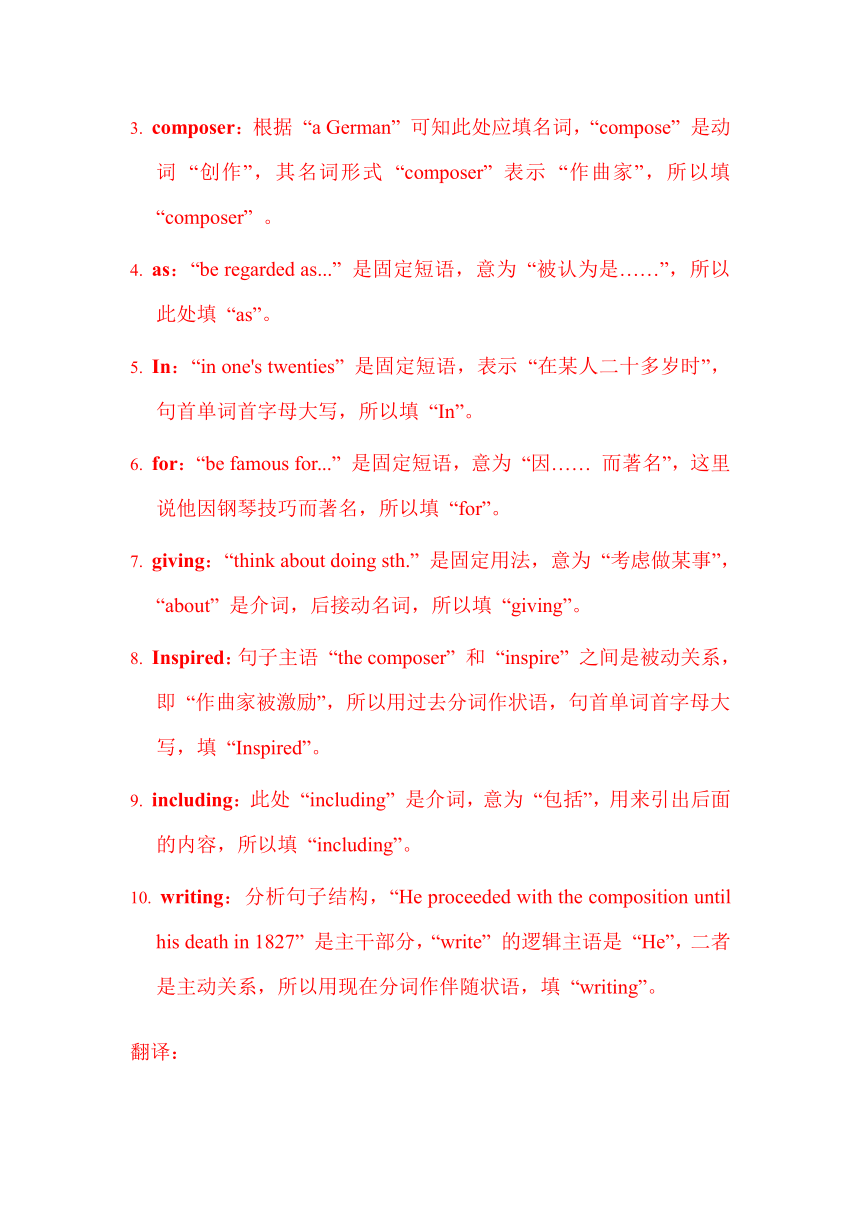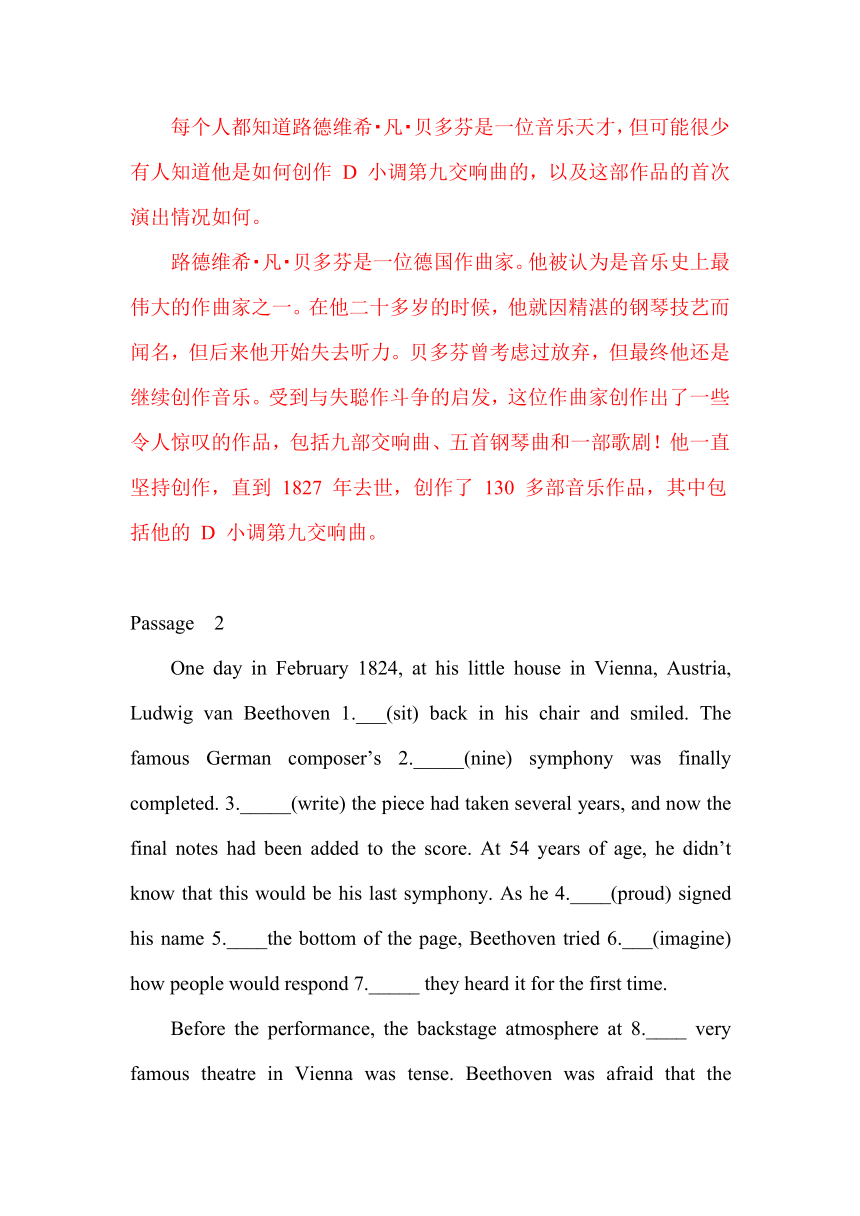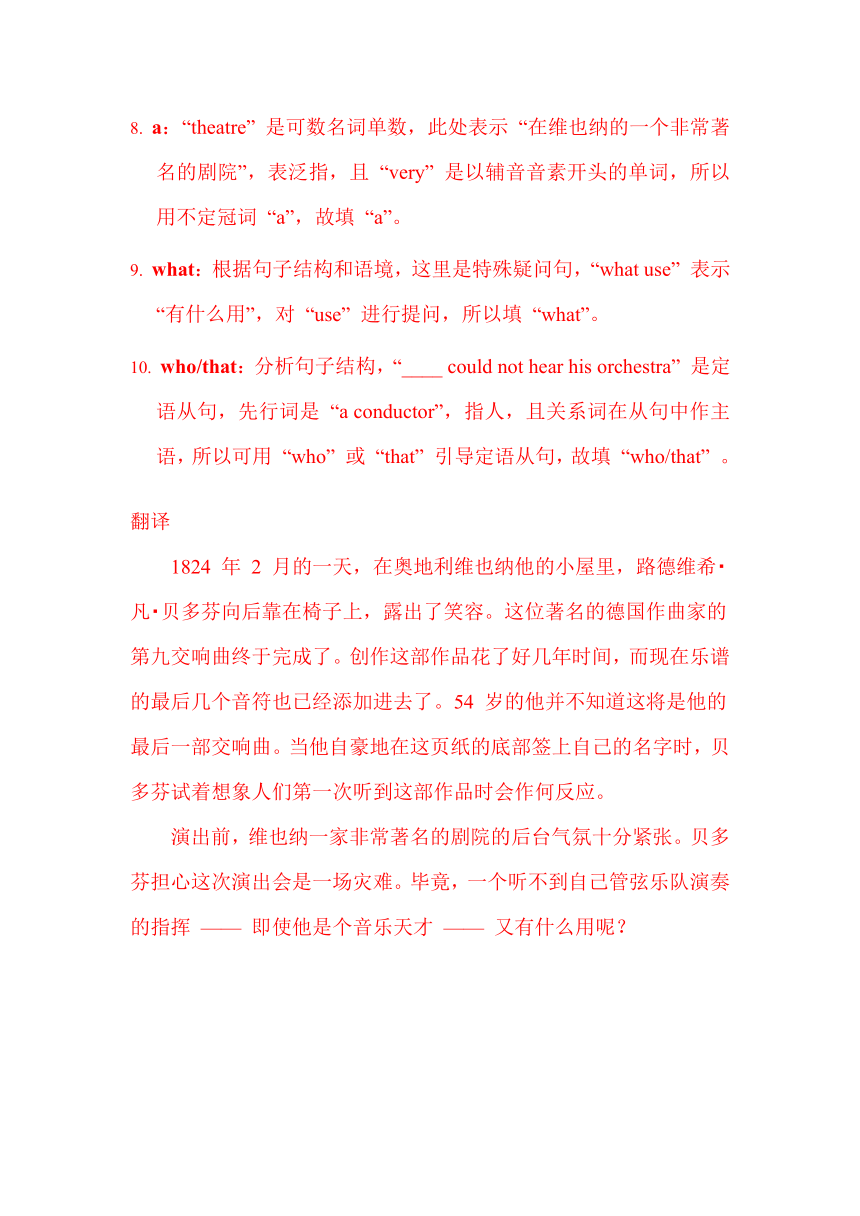北师大版(2019)必修第三册Unit 7 Art Lesson 3 A Musical Genius 课文变形语法填空(含答案)
文档属性
| 名称 | 北师大版(2019)必修第三册Unit 7 Art Lesson 3 A Musical Genius 课文变形语法填空(含答案) |  | |
| 格式 | docx | ||
| 文件大小 | 27.8KB | ||
| 资源类型 | 教案 | ||
| 版本资源 | 北师大版(2019) | ||
| 科目 | 英语 | ||
| 更新时间 | 2025-02-15 11:30:09 | ||
图片预览





文档简介
北师大必修三U7L3 A Musical Genius 课文变形语法填空及知识积累
Passage 1
Everyone knows that Ludwig van Beethoven is a 1.____(music) genius but few might know 2.____ he created Symphony No.9 in D minor and how its first show went.
Ludwig van Beethoven was a German 3.____(compose). He is regarded 4.____ one of the greatest composers in the history of music. 5.____ his twenties, he had been very famous 6.____ his skills on the piano, but then he began to lose his hearing. Beethoven thought about 7.____(give) up, but in the end he continued to write music. 8.____(inspire) by his struggles with deafness, the composer produced some amazing pieces, 9._____(include) nine symphonies, five piano pieces, and an opera! He proceeded with the composition until his death in 1827, 10.____(write) more than 130 musical works, including his Symphony No.9 in D minor.
解析:
musical:修饰名词 “genius”,需要用形容词形式,“musical” 表示 “音乐的”,所以此处填 “musical”。
how:根据后面 “and how its first show went” 可知,此处说很少有人知道他是 “如何” 创作 D 小调第九交响曲的,用 “how” 表示方式,故填 “how”。
composer:根据 “a German” 可知此处应填名词,“compose” 是动词 “创作”,其名词形式 “composer” 表示 “作曲家”,所以填 “composer” 。
as:“be regarded as...” 是固定短语,意为 “被认为是……”,所以此处填 “as”。
In:“in one's twenties” 是固定短语,表示 “在某人二十多岁时”,句首单词首字母大写,所以填 “In”。
for:“be famous for...” 是固定短语,意为 “因…… 而著名”,这里说他因钢琴技巧而著名,所以填 “for”。
giving:“think about doing sth.” 是固定用法,意为 “考虑做某事”,“about” 是介词,后接动名词,所以填 “giving”。
Inspired:句子主语 “the composer” 和 “inspire” 之间是被动关系,即 “作曲家被激励”,所以用过去分词作状语,句首单词首字母大写,填 “Inspired”。
including:此处 “including” 是介词,意为 “包括”,用来引出后面的内容,所以填 “including”。
writing:分析句子结构,“He proceeded with the composition until his death in 1827” 是主干部分,“write” 的逻辑主语是 “He”,二者是主动关系,所以用现在分词作伴随状语,填 “writing”。
翻译:
每个人都知道路德维希 凡 贝多芬是一位音乐天才,但可能很少有人知道他是如何创作 D 小调第九交响曲的,以及这部作品的首次演出情况如何。
路德维希 凡 贝多芬是一位德国作曲家。他被认为是音乐史上最伟大的作曲家之一。在他二十多岁的时候,他就因精湛的钢琴技艺而闻名,但后来他开始失去听力。贝多芬曾考虑过放弃,但最终他还是继续创作音乐。受到与失聪作斗争的启发,这位作曲家创作出了一些令人惊叹的作品,包括九部交响曲、五首钢琴曲和一部歌剧!他一直坚持创作,直到 1827 年去世,创作了 130 多部音乐作品,其中包括他的 D 小调第九交响曲。
Passage 2
One day in February 1824, at his little house in Vienna, Austria, Ludwig van Beethoven 1.___(sit) back in his chair and smiled. The famous German composer’s 2._____(nine) symphony was finally completed. 3._____(write) the piece had taken several years, and now the final notes had been added to the score. At 54 years of age, he didn’t know that this would be his last symphony. As he 4.____(proud) signed his name 5.____the bottom of the page, Beethoven tried 6.___(imagine) how people would respond 7._____ they heard it for the first time.
Before the performance, the backstage atmosphere at 8.____ very famous theatre in Vienna was tense. Beethoven was afraid that the performance would be a disaster. After all, 9.____use is a conductor 10.______ could not hear his orchestra—even if he is a musical genius
解析
sat:根据时间状语 “One day in February 1824” 可知,句子描述的是过去发生的事情,应用一般过去时,“sit” 的过去式是 “sat”,所以此处填 “sat”。
ninth:此处表示 “第九交响曲”,应用序数词,“nine” 的序数词是 “ninth”,故填 “ninth”。
Writing:分析句子结构,“had taken” 是句子的谓语,此处 “write” 作主语,动词作主语要用动名词形式,所以填 “Writing”。
proudly:修饰动词 “signed” 要用副词,“proud” 是形容词,其副词形式是 “proudly”,表示 “自豪地”,故填 “proudly”。
at:“at the bottom of...” 是固定短语,意为 “在…… 底部”,所以此处填 “at”。
to imagine:“try to do sth.” 是固定用法,意为 “努力做某事;试图做某事”,所以此处填 “to imagine”。
when:根据语境,这里表示 “当人们第一次听到它的时候会有怎样的反应”,“when” 引导时间状语从句,意为 “当…… 时候”,故填 “when”。
a:“theatre” 是可数名词单数,此处表示 “在维也纳的一个非常著名的剧院”,表泛指,且 “very” 是以辅音音素开头的单词,所以用不定冠词 “a”,故填 “a”。
what:根据句子结构和语境,这里是特殊疑问句,“what use” 表示 “有什么用”,对 “use” 进行提问,所以填 “what”。
who/that:分析句子结构,“____ could not hear his orchestra” 是定语从句,先行词是 “a conductor”,指人,且关系词在从句中作主语,所以可用 “who” 或 “that” 引导定语从句,故填 “who/that” 。
翻译
1824 年 2 月的一天,在奥地利维也纳他的小屋里,路德维希 凡 贝多芬向后靠在椅子上,露出了笑容。这位著名的德国作曲家的第九交响曲终于完成了。创作这部作品花了好几年时间,而现在乐谱的最后几个音符也已经添加进去了。54 岁的他并不知道这将是他的最后一部交响曲。当他自豪地在这页纸的底部签上自己的名字时,贝多芬试着想象人们第一次听到这部作品时会作何反应。
演出前,维也纳一家非常著名的剧院的后台气氛十分紧张。贝多芬担心这次演出会是一场灾难。毕竟,一个听不到自己管弦乐队演奏的指挥 —— 即使他是个音乐天才 —— 又有什么用呢?
Passage 3
The audience did not hesitate 1._____(applaud) loudly as the famous composer walked out onto the stage for the first time in 12 years. The theatre’s musical director, Michael Umlauf, joined him and together the two men 2.___(take) charge of the orchestra. For more than 3.____ hour, Beethoven jumped about in front of the orchestra, 4.______(wave) his arms wildly in the air, and 5.______(mad) turning the pages of his score. The whole time, Umlauf stood quietly by his side, skillfully 6._____(guide) the orchestra through the most amazing piece of music the world had ever known.
As the final, joyous note signal 7._____(lead) the end of the symphony, the audience jumped to their feet, 8.______(clap), cheering and waving their hats. But Beethoven continued conducting, his head 9._____(bury) in the score. It was not until Caroline Unger, one of the singers, took his arm and turned him to face the audience 10.____the great man realised his symphony was a success.
Later, Caroline remembered that Beethoven was not the only one 11._____ got a surprise. “The audience was shocked as well,” she said with a broad smile. “Most of them had no idea that he was deaf! The one person in the room who didn’t hear the symphony—and never would—was the very man who composed it.”
解析
to applaud:“hesitate to do sth.” 是固定用法,意为 “犹豫做某事;迟疑做某事”,这里表示观众毫不犹豫地热烈鼓掌,所以填 “to applaud”。
took:根据前文可知,文章描述的是过去发生的事情,时态为一般过去时,“take” 的过去式是 “took”,“take charge of” 意为 “负责;掌管”,所以此处填 “took”。
an:“hour” 是以元音音素开头的单词,“more than an hour” 表示 “一个多小时”,表泛指,所以用不定冠词 “an”,故填 “an”。
waving:分析句子结构,“Beethoven jumped about in front of the orchestra” 是句子的主干,“wave” 和 “Beethoven” 之间是主动关系,且与后面的 “turning” 并列,作伴随状语,所以用现在分词形式 “waving”。
madly:修饰动词 “turning” 要用副词,“mad” 是形容词,其副词形式是 “madly”,表示 “疯狂地”,故填 “madly”。
guiding:“Umlauf stood quietly by his side” 是句子的主干,“guide” 和 “Umlauf” 之间是主动关系,用现在分词作伴随状语,所以填 “guiding”。
led:根据文章整体时态为一般过去时,“lead” 的过去式是 “led”,“lead the end of...” 表示 “引领…… 的结束”,所以此处填 “led”。
clapping:“the audience jumped to their feet” 是句子的主干,“clap” 和 “the audience” 之间是主动关系,且与 “cheering” 和 “waving” 并列,作伴随状语,所以用现在分词形式 “clapping”。
buried:“his head” 和 “bury” 之间是被动关系,“bury one's head in...” 意为 “埋头于……”,这里用过去分词 “buried” 作宾语补足语,补充说明 “his head” 的状态,故填 “buried”。
that:“It was not until...that...” 是强调句型,强调时间状语 “until Caroline Unger, one of the singers, took his arm and turned him to face the audience”,所以此处填 “that”。
who/that:分析句子结构,“____ got a surprise” 是定语从句,先行词是 “the only one”(指人),且关系词在从句中作主语,所以可用 “who” 或 “that” 引导定语从句,故填 “who/that” 。
翻译:
当这位著名的作曲家 12 年来首次走上舞台时,观众们毫不犹豫地热烈鼓起掌来。剧院的音乐总监迈克尔 乌姆劳夫(Michael Umlauf)走到他身旁,两人一同指挥起了管弦乐队。在一个多小时的时间里,贝多芬在管弦乐队面前跳来跳去,在空中疯狂地挥舞着手臂,还疯狂地翻动着乐谱。在整个过程中,乌姆劳夫静静地站在他身边,熟练地引导着管弦乐队演奏着这首世界上最令人惊叹的乐曲。
当最后一个欢快的音符为这部交响曲画上句号时,观众们一跃而起,鼓掌、欢呼,还挥舞着他们的帽子。但贝多芬仍继续指挥着,他的头埋在乐谱中。直到其中一位歌手卡罗琳 翁格(Caroline Unger)拉住他的手臂,让他转过身面向观众,这位伟大的作曲家才意识到自己的交响曲获得了成功。
后来,卡罗琳回忆道,感到惊喜的不止贝多芬一个人。“观众们也很震惊,” 她笑容满面地说道,“他们中的大多数人都不知道他已经失聪了!在这个房间里唯一一个听不到这部交响曲 —— 而且永远也听不到的人 —— 恰恰就是创作它的那个人。
课文重点短语积累
be regarded as:被认为是……
in one's twenties:在某人二十多岁时
be famous for:因…… 而著名
think about:考虑
give up:放弃
be inspired by:受到…… 的启发
proceed with:继续进行
at the bottom of:在…… 底部
try to do sth.:努力做某事;试图做某事
hesitate to do sth.:犹豫做某事;迟疑做某事
take charge of:负责;掌管
wave one's arms:挥舞某人的手臂
jump to one's feet:一跃而起
be buried in:埋头于;专心于
It was not until...that...:直到…… 才……
课文重要句型
Everyone knows that...but few might know... 每个人都知道…… 但可能很少有人知道……
例句:Everyone knows that Ludwig van Beethoven is a musical genius but few might know how he created Symphony No.9 in D minor and how its first show went.(用于对比普遍认知和鲜为人知的信息,突出文章要讲述的重点内容)
be regarded as... 被认为是……(被动语态结构,常用于描述某人或某物的地位或评价)
例句:He is regarded as one of the greatest composers in the history of music.
In one's twenties,... 在某人二十多岁时,……(表示在某个年龄段发生的事情)
例句:In his twenties, he had been very famous for his skills on the piano, but then he began to lose his hearing.
think about doing sth. 考虑做某事(about 为介词,后接动名词)
例句:Beethoven thought about giving up, but in the end he continued to write music.
Inspired by..., sb. did... 受到…… 的启发,某人做了……(过去分词短语作状语,表示原因)
例句:Inspired by his struggles with deafness, the composer produced some amazing pieces, including nine symphonies, five piano pieces, and an opera!
It was not until...that... 直到…… 才……(强调句型,强调时间状语)
例句:It was not until Caroline Unger, one of the singers, took his arm and turned him to face the audience that the great man realised his symphony was a success.
As... 当…… 时候;随着……(引导时间状语从句)
例句:As the final, joyous note signal led the end of the symphony, the audience jumped to their feet, clapping, cheering and waving their hats.
what use is... …… 有什么用(特殊疑问句,用于表达对某种情况的质疑)
例句:After all, what use is a conductor who could not hear his orchestra—even if he is a musical genius
Passage 1
Everyone knows that Ludwig van Beethoven is a 1.____(music) genius but few might know 2.____ he created Symphony No.9 in D minor and how its first show went.
Ludwig van Beethoven was a German 3.____(compose). He is regarded 4.____ one of the greatest composers in the history of music. 5.____ his twenties, he had been very famous 6.____ his skills on the piano, but then he began to lose his hearing. Beethoven thought about 7.____(give) up, but in the end he continued to write music. 8.____(inspire) by his struggles with deafness, the composer produced some amazing pieces, 9._____(include) nine symphonies, five piano pieces, and an opera! He proceeded with the composition until his death in 1827, 10.____(write) more than 130 musical works, including his Symphony No.9 in D minor.
解析:
musical:修饰名词 “genius”,需要用形容词形式,“musical” 表示 “音乐的”,所以此处填 “musical”。
how:根据后面 “and how its first show went” 可知,此处说很少有人知道他是 “如何” 创作 D 小调第九交响曲的,用 “how” 表示方式,故填 “how”。
composer:根据 “a German” 可知此处应填名词,“compose” 是动词 “创作”,其名词形式 “composer” 表示 “作曲家”,所以填 “composer” 。
as:“be regarded as...” 是固定短语,意为 “被认为是……”,所以此处填 “as”。
In:“in one's twenties” 是固定短语,表示 “在某人二十多岁时”,句首单词首字母大写,所以填 “In”。
for:“be famous for...” 是固定短语,意为 “因…… 而著名”,这里说他因钢琴技巧而著名,所以填 “for”。
giving:“think about doing sth.” 是固定用法,意为 “考虑做某事”,“about” 是介词,后接动名词,所以填 “giving”。
Inspired:句子主语 “the composer” 和 “inspire” 之间是被动关系,即 “作曲家被激励”,所以用过去分词作状语,句首单词首字母大写,填 “Inspired”。
including:此处 “including” 是介词,意为 “包括”,用来引出后面的内容,所以填 “including”。
writing:分析句子结构,“He proceeded with the composition until his death in 1827” 是主干部分,“write” 的逻辑主语是 “He”,二者是主动关系,所以用现在分词作伴随状语,填 “writing”。
翻译:
每个人都知道路德维希 凡 贝多芬是一位音乐天才,但可能很少有人知道他是如何创作 D 小调第九交响曲的,以及这部作品的首次演出情况如何。
路德维希 凡 贝多芬是一位德国作曲家。他被认为是音乐史上最伟大的作曲家之一。在他二十多岁的时候,他就因精湛的钢琴技艺而闻名,但后来他开始失去听力。贝多芬曾考虑过放弃,但最终他还是继续创作音乐。受到与失聪作斗争的启发,这位作曲家创作出了一些令人惊叹的作品,包括九部交响曲、五首钢琴曲和一部歌剧!他一直坚持创作,直到 1827 年去世,创作了 130 多部音乐作品,其中包括他的 D 小调第九交响曲。
Passage 2
One day in February 1824, at his little house in Vienna, Austria, Ludwig van Beethoven 1.___(sit) back in his chair and smiled. The famous German composer’s 2._____(nine) symphony was finally completed. 3._____(write) the piece had taken several years, and now the final notes had been added to the score. At 54 years of age, he didn’t know that this would be his last symphony. As he 4.____(proud) signed his name 5.____the bottom of the page, Beethoven tried 6.___(imagine) how people would respond 7._____ they heard it for the first time.
Before the performance, the backstage atmosphere at 8.____ very famous theatre in Vienna was tense. Beethoven was afraid that the performance would be a disaster. After all, 9.____use is a conductor 10.______ could not hear his orchestra—even if he is a musical genius
解析
sat:根据时间状语 “One day in February 1824” 可知,句子描述的是过去发生的事情,应用一般过去时,“sit” 的过去式是 “sat”,所以此处填 “sat”。
ninth:此处表示 “第九交响曲”,应用序数词,“nine” 的序数词是 “ninth”,故填 “ninth”。
Writing:分析句子结构,“had taken” 是句子的谓语,此处 “write” 作主语,动词作主语要用动名词形式,所以填 “Writing”。
proudly:修饰动词 “signed” 要用副词,“proud” 是形容词,其副词形式是 “proudly”,表示 “自豪地”,故填 “proudly”。
at:“at the bottom of...” 是固定短语,意为 “在…… 底部”,所以此处填 “at”。
to imagine:“try to do sth.” 是固定用法,意为 “努力做某事;试图做某事”,所以此处填 “to imagine”。
when:根据语境,这里表示 “当人们第一次听到它的时候会有怎样的反应”,“when” 引导时间状语从句,意为 “当…… 时候”,故填 “when”。
a:“theatre” 是可数名词单数,此处表示 “在维也纳的一个非常著名的剧院”,表泛指,且 “very” 是以辅音音素开头的单词,所以用不定冠词 “a”,故填 “a”。
what:根据句子结构和语境,这里是特殊疑问句,“what use” 表示 “有什么用”,对 “use” 进行提问,所以填 “what”。
who/that:分析句子结构,“____ could not hear his orchestra” 是定语从句,先行词是 “a conductor”,指人,且关系词在从句中作主语,所以可用 “who” 或 “that” 引导定语从句,故填 “who/that” 。
翻译
1824 年 2 月的一天,在奥地利维也纳他的小屋里,路德维希 凡 贝多芬向后靠在椅子上,露出了笑容。这位著名的德国作曲家的第九交响曲终于完成了。创作这部作品花了好几年时间,而现在乐谱的最后几个音符也已经添加进去了。54 岁的他并不知道这将是他的最后一部交响曲。当他自豪地在这页纸的底部签上自己的名字时,贝多芬试着想象人们第一次听到这部作品时会作何反应。
演出前,维也纳一家非常著名的剧院的后台气氛十分紧张。贝多芬担心这次演出会是一场灾难。毕竟,一个听不到自己管弦乐队演奏的指挥 —— 即使他是个音乐天才 —— 又有什么用呢?
Passage 3
The audience did not hesitate 1._____(applaud) loudly as the famous composer walked out onto the stage for the first time in 12 years. The theatre’s musical director, Michael Umlauf, joined him and together the two men 2.___(take) charge of the orchestra. For more than 3.____ hour, Beethoven jumped about in front of the orchestra, 4.______(wave) his arms wildly in the air, and 5.______(mad) turning the pages of his score. The whole time, Umlauf stood quietly by his side, skillfully 6._____(guide) the orchestra through the most amazing piece of music the world had ever known.
As the final, joyous note signal 7._____(lead) the end of the symphony, the audience jumped to their feet, 8.______(clap), cheering and waving their hats. But Beethoven continued conducting, his head 9._____(bury) in the score. It was not until Caroline Unger, one of the singers, took his arm and turned him to face the audience 10.____the great man realised his symphony was a success.
Later, Caroline remembered that Beethoven was not the only one 11._____ got a surprise. “The audience was shocked as well,” she said with a broad smile. “Most of them had no idea that he was deaf! The one person in the room who didn’t hear the symphony—and never would—was the very man who composed it.”
解析
to applaud:“hesitate to do sth.” 是固定用法,意为 “犹豫做某事;迟疑做某事”,这里表示观众毫不犹豫地热烈鼓掌,所以填 “to applaud”。
took:根据前文可知,文章描述的是过去发生的事情,时态为一般过去时,“take” 的过去式是 “took”,“take charge of” 意为 “负责;掌管”,所以此处填 “took”。
an:“hour” 是以元音音素开头的单词,“more than an hour” 表示 “一个多小时”,表泛指,所以用不定冠词 “an”,故填 “an”。
waving:分析句子结构,“Beethoven jumped about in front of the orchestra” 是句子的主干,“wave” 和 “Beethoven” 之间是主动关系,且与后面的 “turning” 并列,作伴随状语,所以用现在分词形式 “waving”。
madly:修饰动词 “turning” 要用副词,“mad” 是形容词,其副词形式是 “madly”,表示 “疯狂地”,故填 “madly”。
guiding:“Umlauf stood quietly by his side” 是句子的主干,“guide” 和 “Umlauf” 之间是主动关系,用现在分词作伴随状语,所以填 “guiding”。
led:根据文章整体时态为一般过去时,“lead” 的过去式是 “led”,“lead the end of...” 表示 “引领…… 的结束”,所以此处填 “led”。
clapping:“the audience jumped to their feet” 是句子的主干,“clap” 和 “the audience” 之间是主动关系,且与 “cheering” 和 “waving” 并列,作伴随状语,所以用现在分词形式 “clapping”。
buried:“his head” 和 “bury” 之间是被动关系,“bury one's head in...” 意为 “埋头于……”,这里用过去分词 “buried” 作宾语补足语,补充说明 “his head” 的状态,故填 “buried”。
that:“It was not until...that...” 是强调句型,强调时间状语 “until Caroline Unger, one of the singers, took his arm and turned him to face the audience”,所以此处填 “that”。
who/that:分析句子结构,“____ got a surprise” 是定语从句,先行词是 “the only one”(指人),且关系词在从句中作主语,所以可用 “who” 或 “that” 引导定语从句,故填 “who/that” 。
翻译:
当这位著名的作曲家 12 年来首次走上舞台时,观众们毫不犹豫地热烈鼓起掌来。剧院的音乐总监迈克尔 乌姆劳夫(Michael Umlauf)走到他身旁,两人一同指挥起了管弦乐队。在一个多小时的时间里,贝多芬在管弦乐队面前跳来跳去,在空中疯狂地挥舞着手臂,还疯狂地翻动着乐谱。在整个过程中,乌姆劳夫静静地站在他身边,熟练地引导着管弦乐队演奏着这首世界上最令人惊叹的乐曲。
当最后一个欢快的音符为这部交响曲画上句号时,观众们一跃而起,鼓掌、欢呼,还挥舞着他们的帽子。但贝多芬仍继续指挥着,他的头埋在乐谱中。直到其中一位歌手卡罗琳 翁格(Caroline Unger)拉住他的手臂,让他转过身面向观众,这位伟大的作曲家才意识到自己的交响曲获得了成功。
后来,卡罗琳回忆道,感到惊喜的不止贝多芬一个人。“观众们也很震惊,” 她笑容满面地说道,“他们中的大多数人都不知道他已经失聪了!在这个房间里唯一一个听不到这部交响曲 —— 而且永远也听不到的人 —— 恰恰就是创作它的那个人。
课文重点短语积累
be regarded as:被认为是……
in one's twenties:在某人二十多岁时
be famous for:因…… 而著名
think about:考虑
give up:放弃
be inspired by:受到…… 的启发
proceed with:继续进行
at the bottom of:在…… 底部
try to do sth.:努力做某事;试图做某事
hesitate to do sth.:犹豫做某事;迟疑做某事
take charge of:负责;掌管
wave one's arms:挥舞某人的手臂
jump to one's feet:一跃而起
be buried in:埋头于;专心于
It was not until...that...:直到…… 才……
课文重要句型
Everyone knows that...but few might know... 每个人都知道…… 但可能很少有人知道……
例句:Everyone knows that Ludwig van Beethoven is a musical genius but few might know how he created Symphony No.9 in D minor and how its first show went.(用于对比普遍认知和鲜为人知的信息,突出文章要讲述的重点内容)
be regarded as... 被认为是……(被动语态结构,常用于描述某人或某物的地位或评价)
例句:He is regarded as one of the greatest composers in the history of music.
In one's twenties,... 在某人二十多岁时,……(表示在某个年龄段发生的事情)
例句:In his twenties, he had been very famous for his skills on the piano, but then he began to lose his hearing.
think about doing sth. 考虑做某事(about 为介词,后接动名词)
例句:Beethoven thought about giving up, but in the end he continued to write music.
Inspired by..., sb. did... 受到…… 的启发,某人做了……(过去分词短语作状语,表示原因)
例句:Inspired by his struggles with deafness, the composer produced some amazing pieces, including nine symphonies, five piano pieces, and an opera!
It was not until...that... 直到…… 才……(强调句型,强调时间状语)
例句:It was not until Caroline Unger, one of the singers, took his arm and turned him to face the audience that the great man realised his symphony was a success.
As... 当…… 时候;随着……(引导时间状语从句)
例句:As the final, joyous note signal led the end of the symphony, the audience jumped to their feet, clapping, cheering and waving their hats.
what use is... …… 有什么用(特殊疑问句,用于表达对某种情况的质疑)
例句:After all, what use is a conductor who could not hear his orchestra—even if he is a musical genius
同课章节目录
- Unit 7 Art
- Lesson 1 Masterpieces
- Lesson 2 Beijing Opera
- Lesson 3 A Musical Genius
- Unit 8 Green living
- Lesson 1 Roots and Shoots
- Lesson 2 Greening the Desert
- Lesson 3 "White Bikes" on the Road
- Unit 9 Learning
- Lesson 1 Active Learning
- Lesson 2 Language Learning Tips
- Lesson 3 The Secrets of Your Memory
